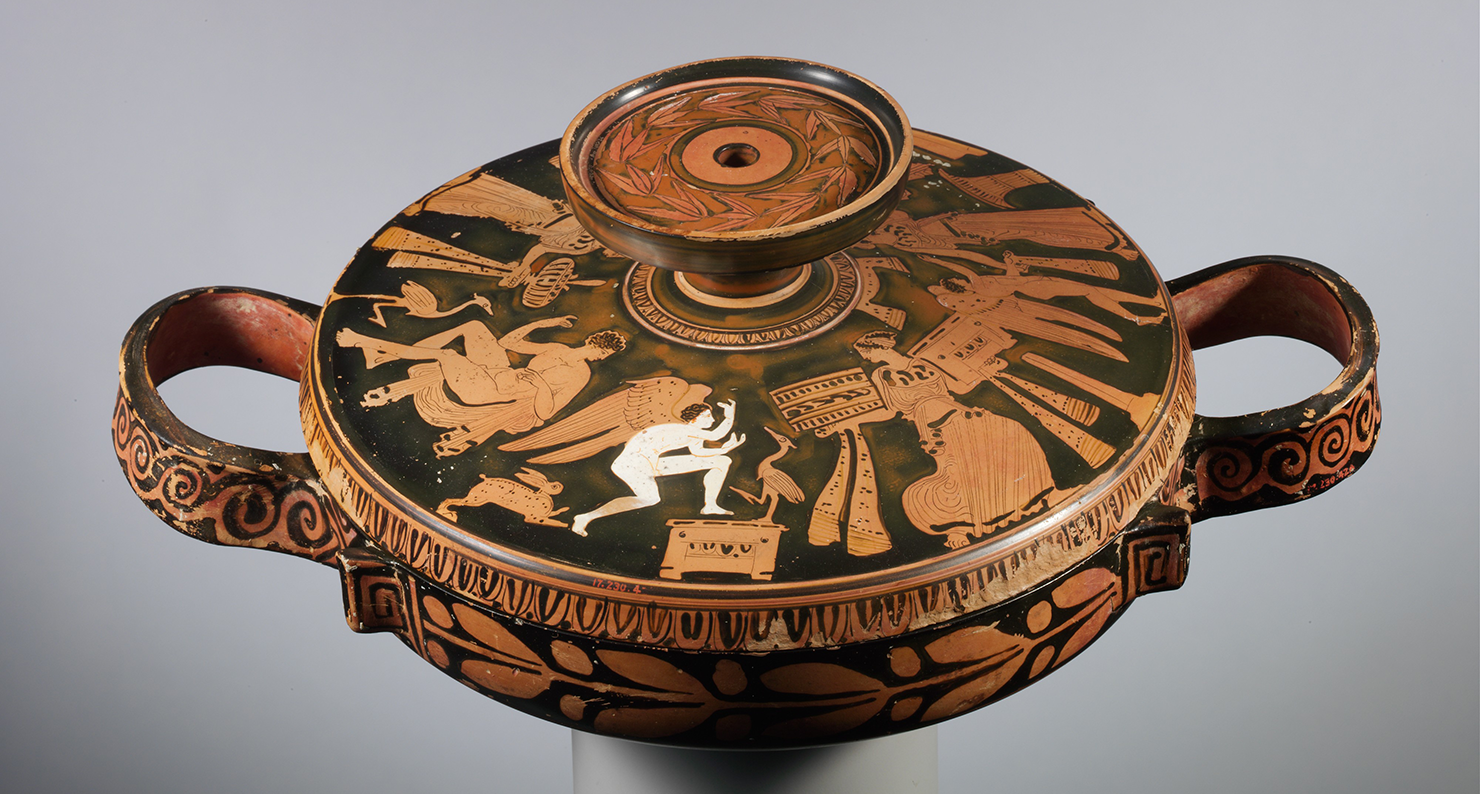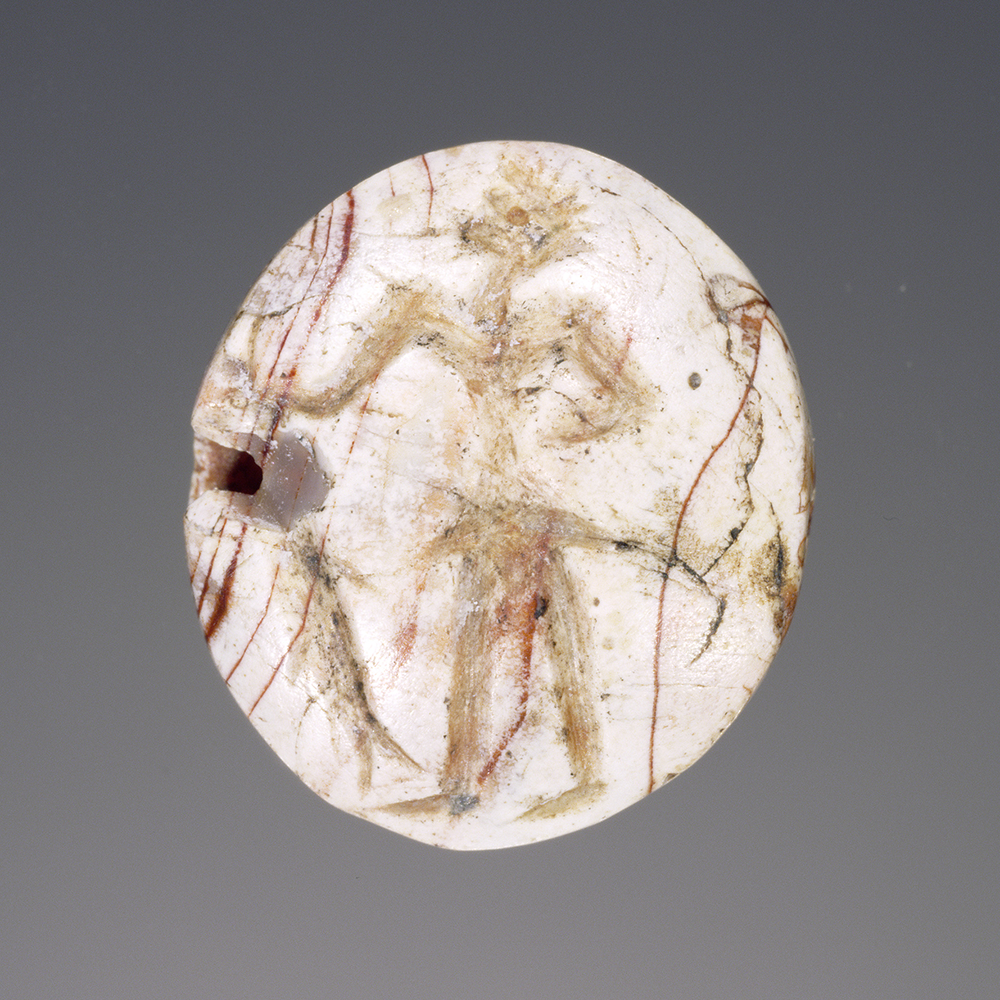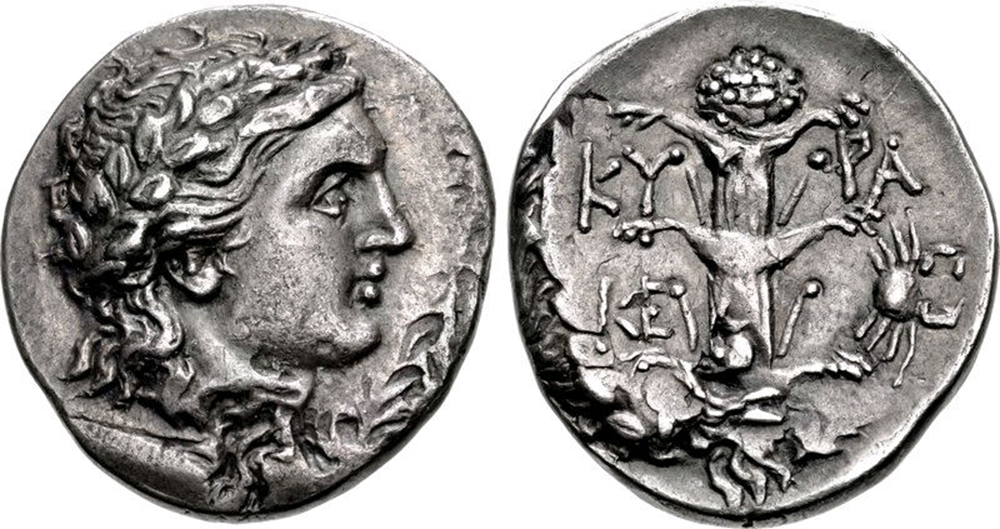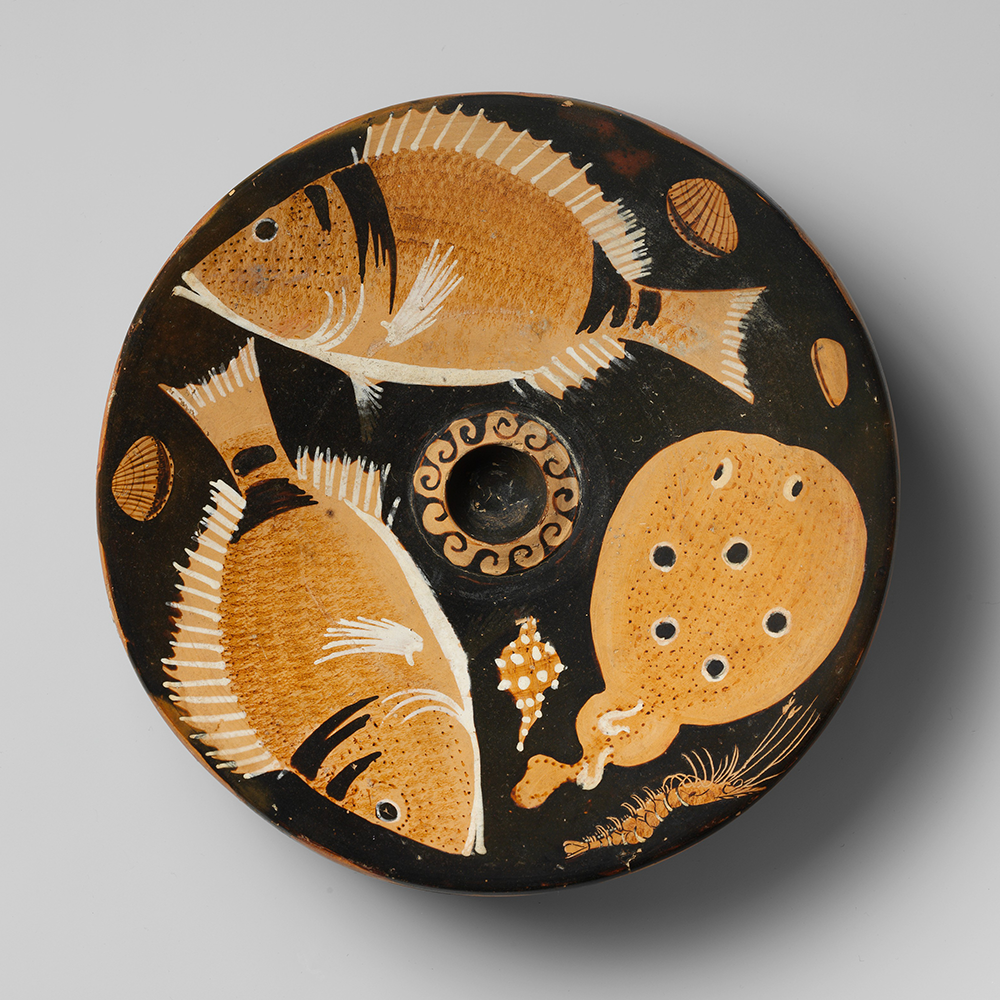
Women, youths, and Erotes appear on the lid of this terra-cotta lekanis (covered dish), connected with the Otchët Group, c. 400 BC. The Metropolitan Museum of Art, Rogers Fund, 1917.
For classical Athens there is a wealth of literary evidence for food, including one short fragment of comedy that offers a whole menu for a festive deipnon. The play is just beginning, and a speaker has noticed that something is wrong: the household behind one of the stage doors ought to be toasting a happy event (the Amphidromia were celebrated five or ten days after a baby was born) but, for some reason, it isn’t:
Well, then, why is there no wreath in front of the door? Why does no smell of cooking strike the tip of my exploring nose, if it’s their Amphidromia?—when the custom is to bake a slice of Chersonese cheese, to fry some cabbage gleaming with oil, to stew some fat mutton chops, to pluck wood-pigeons and thrushes along with chaffinches, to nibble little cuttlefish along with squids, to swing and beat many a tentacle, and to drink many a cup of wine not too much diluted.
There, alongside mutton chops from a sacrificed sheep or lamb, we have melted cheese, fried sliced cabbage, wild birds, and seafood including octopus (owner of the tentacles that must be beaten to tenderize them).
Fresh meat—meaning specifically the fresh meat of domestic animals—would be on the classical menu only after a sacrifice: this was a firm rule. Wild game was different—it didn’t have to be offered to a god—but there was not much game to be had around classical Athens. The only likely catch was hare, a love-gift that demonstrated the lover’s hunting skill or generosity. Which of the two? That would depend on whether it was caught—in accordance with the advice of Xenophon’s little manual of hunting, which assumes that hare will be the usual catch—or bought. Hare was no commoner in the classical diet than other fresh meats, but we are lucky enough to have one classical recipe for it, or rather, a choice of recipes from which we are very firmly guided toward one. Archestratos, Greece’s first gastronomic poet, writing about 350 BC, pronounces on the subject in his inimitable way:
There are many ways, many rules for the preparation of hare. This is the best, to bring the roast meat in and serve to each while they are drinking hot, simply sprinkled with salt, taking it from the spit while still a little rare. Don’t worry if you see the ichor seeping from the meat, but eat greedily. To me the other recipes are altogether out of place, gluey sauces over it, cheese over it, too much oil over it, as if you were cooking a weasel.
Homer and Hesiod never mention seafood at all, but to judge by the written texts fish was far commoner than fresh meat at dinner in classical Athens. Fragments from an astonishing range of Athenian comedies show aspects of the fish business, from market to kitchen to table. Athenians were not fishermen. If they wanted fish, they paid for it, and the price of fish—always higher than it ought to be—was a surprisingly common topic of conversation. There was even a book about it: “Lynkeus of Samos wrote Shopping for Fish for one of his friends who disliked shopping: it told him how much he should offer to the murderous fishmongers to get what he wanted reasonably and painlessly.” From this bible of the fourth-century gastronome one extract survives:
To quell their steely gaze and unwavering prices it is not ineffective to stand over the fish and criticize it, recalling Archestratos or another such poet, and quoting the line: The inshore mormyros, a poor fish, never worthy; and if it’s spring: Bonito? Buy in autumn…; and if it’s summer: Gray mullet’s wonderful when winter comes! There are many possibilities. You will frighten off most of the shoppers and bystanders, and so the man will have to settle at the price you choose.
These little embedded verses are not real quotations but a literary game at which Lynkeus’ friend is assumed to be able to beat the fishmonger. It was Hesiod who wrote “never worthy,” not about a bream but about Askra, his hometown. Archestratos did advise cooking bonito in autumn, but not in those words.

Once the fish was bought, it had to be cooked, and comedy cooks are full of information on how to treat each species in the astonishingly wide range to be found in the Athenian market. One speaker in a comedy by Sotades, equally proud of his market and kitchen skills, lists a whole marine banquet: shrimp cooked in the frying pan; a galeos dogfish—“I’ve baked the middle pieces, I’m boiling the rest of it with a mulberry sauce to go with it”; two bluefish steaks—“into a casserole with them, with a few herbs, cumin, salt, water, and a drop of olive oil”; “a very fine sea bass: to be cooked in stock with oil and herbs, after taking off the steaks to be grilled on spits”; red mullets and wrasses on the grill, dressed with oil and oregano; a boiled stuffed squid; cuttlefish tentacles simply roasted, with “a side salad of all sorts of greens”; small fry dressed with oil; a conger cooked in “stock with strong herb flavors”; gobies and rockfish, dredged in flour and fried; a bonito “dipped in oil, wrapped in fig leaves, sprinkled with oregano, and hidden like a firebrand under heaped ashes”; “some little Phaleron anchovies: a cup of water over these is enough; I’ll chop herbs and tip them on with a good jug of oil…That’s the art, and you don’t learn it from books and notes.” Sometimes the recipes are given as instructions from a cook to a slave. This sharp dialogue is by Antiphanes:
“No, no, the stone bass to simmer in brine, as I told you before.”
“And the sea bass?”
“Bake whole.”
“The galeos?”
“Boil with fresh chopped herbs.”
“The eel?”
“Salt, oregano, water.”
“The conger?”
“Same.”
“The ray?”
“Greens.”
“There’s a slice of tuna.”
“Bake it.”
“The kid?”
“Roast it.”
“The other?”
“The opposite.”
“The spleen?”
“Stuffed.”
What’s surprising is that however jokily the topic is inserted into comedy dialogue—“Do you know how to cook horse mackerel?” “I will when you’ve told me”—the recipes are real. We know this not just because they make good sense, but also because they agree with other recipes on the few occasions when other recipes survive.
Notice the simplicity. No cumin, no coriander, not even onions and garlic, though these were welcome in their proper place. Fish wanted nothing but olive oil, good fresh herbs, and occasionally good wild greens. No spices—certainly not pepper, which was still vanishingly rare in Europe. Even the two exotic spices known to have been in use in classical Athens do not show up in fish cookery: fruity sumac, familiar to Mycenaeans, and the legendary silphion of ancient Libya.

Silphion was the resin of a sturdy fennel-like plant that was never found naturalized beyond north Africa. It was imported to Greece, sold at a high price, and prized by classical cooks and dieticians, who thought it good for the stomach. It was grated, along with cheese, vinegar, and oil, onto birds for roasting, and similarly served with cheese and vinegar to flavor fish. It was an ingredient in marinades and sauces. Its role in luxury Greek cuisine can be compared with that of garlic in French cookery. The Romans learned about silphion from the Greeks and liked to eat the whole root and stem, sliced and preserved in vinegar. They overexploited it: “The single stem found within living memory was sent to the emperor Nero,” Pliny reports sadly. Alexander’s troops had meanwhile discovered a silphion substitute in Central Asia, the resin known to us as asafetida, but this was never adopted into Greek cuisine.
One other important flavor was new to classical Greece. This was garos, fish sauce, a Greek or Phoenician invention, first made at Greek colonies in the Crimea and at Greek and Carthaginian colonies on the Mediterranean coast of Spain, where archaeologists have found large-scale facilities. From the producers’ point of view it was an excellent way to use the offcuts and innards of fish that were destined for export, dried, smoked, or salted. From the ancient cook’s point of view garos was a fermented sauce, one of those familiar in many parts of the world that add savor and saltiness. Soy sauce is the best known, but those who want to get closest to the ancient garos use Southeast Asian fish sauce, made in exactly the same way. The fashion for garos was transmitted to the Romans and preserved (so to speak) in the Byzantine Empire, and the known historic recipes, intended for small-scale production at a farm near the sea, are Byzantine. Two variants follow:
Making garos. The so-called liquamen is made thus. Fish entrails are put in a container and salted; and little fish, especially sand smelt or small red mullet or mendole or anchovy, or any small enough, are all similarly salted; and left to pickle in the sun, stirring frequently. When the heat has pickled them, the garos is got from them thus: a deep close-woven basket is inserted into the center of the vessel containing these fish, and the garos flows into the basket.
A rather high-quality garos, called haimation, is made thus. Take tunny entrails with the gills, fluid, and blood, sprinkle with sufficient salt, leave in a vessel for two months at the most; then pierce the jar, and the garos called haimation flows out.
Well known by the fifth century BC (the tragedian Aeschylus, curiously, is the earliest known writer to mention it), garos remained an everyday item until the sixteenth century, when Pierre Belon, a French naturalist, encountered it in Ottoman Constantinople—but this is its last gasp:
The garum-makers of Constantinople are mostly in Pera. They prepare fresh fish daily, sell it fried, and make use of the entrails and roe, steeping them in brine to turn them into garum. It matters a good deal which fish is used. Only the scad, which the Venetians call suro, and mackerel, will do.

There were classical Greeks who had no money for buying meat or fish, let alone imported sauces and spices. “These things the poor cannot buy,” a greedy speaker in a comedy fragment reminds us, “the belly of a tuna, the head of a bass or a conger, or cuttlefishes, which I think even the blessed gods do not despise.” What proportion of Athenians were “poor” in this sense is not known, but, since state festivals meant free food, they would certainly have been present in the comedy audience, twice a year, to recognize themselves in speeches like these:
My man is a beggar, I am a poor old woman: our daughter, our son a mere child, and this good girl here, that makes five of us, three to dinner and two to share a little barley-cake with them…The parts and the whole of our life are bean, lupin, potherb, turnip, cowpea, grass pea, acorn, bolbos, cicada, chickpea, wild pear, and the sun-baked heritage that I love so dearly, the dried fig.
One of the items in this list of local, traditional, non-meat foods that would have cost practically nothing deserves a second glance. Native to Greece, considered a delicacy by many in ancient as in modern times, bolboi (grape hyacinth or tassel hyacinth bulbs) are often gathered from the wild and were seen by ancient Athenians among the vegetables that gardeners from neighboring Megara would bring to market. They once had an aphrodisiac reputation. “Bring from Megara the fertilizing seeds of the bulb that arouse men and arm them for intercourse with women,” wrote the Latin agricultural poet Columella. That reputation has long since withered away, but bulbs are still a popular side dish in some parts of Greece, though they need long baking (traditionally under hot ashes) and, as a Greek comedy had already emphasized, sympathetic seasoning: “Look, if you please, at how highly the bulb is regarded for its extravagance: it insists on cheese, honey, sesame, olive oil, onion, vinegar, silphion. All on its own it is mean and sour.” The ancient Roman cookbook Apicius suggests some Roman ways with this Greek specialty:
Bulbs. Serve in oil, fish sauce, vinegar, with a little cumin sprinkled over.—Or, mash and boil in water, then fry in oil. Make a sauce thus: thyme, pennyroyal, pepper, oregano, honey, a little vinegar, and, if liked, a little fish sauce. Sprinkle pepper over and serve.—Or, boil and press into a pan, adding thyme, oregano, honey, vinegar, concentrated must, dates, fish sauce, and a little oil. Sprinkle pepper over and serve.
Reprinted with permission from Gifts of the Gods: A History of Food in Greece by Andrew and Rachel Dalby, published by Reaktion Books Ltd. Copyright © 2017 by Andrew Dalby and Rachel Dalby. All rights reserved.